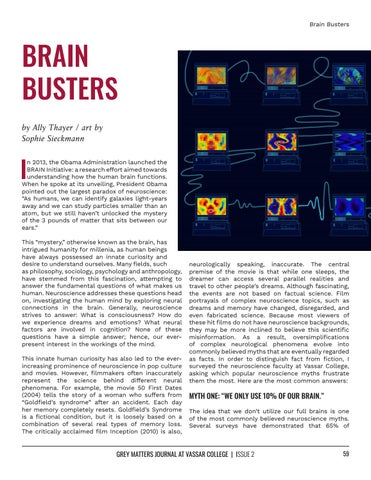Brain Busters
BRAIN BUSTERS by Ally Thayer / art by Sophie Sieckmann
I
n 2013, the Obama Administration launched the BRAIN Initiative: a research effort aimed towards understanding how the human brain functions. When he spoke at its unveiling, President Obama pointed out the largest paradox of neuroscience: “As humans, we can identify galaxies light-years away and we can study particles smaller than an atom, but we still haven’t unlocked the mystery of the 3 pounds of matter that sits between our ears.” This “mystery,” otherwise known as the brain, has intrigued humanity for millenia, as human beings have always possessed an innate curiosity and desire to understand ourselves. Many fields, such as philosophy, sociology, psychology and anthropology, have stemmed from this fascination, attempting to answer the fundamental questions of what makes us human. Neuroscience addresses these questions head on, investigating the human mind by exploring neural connections in the brain. Generally, neuroscience strives to answer: What is consciousness? How do we experience dreams and emotions? What neural factors are involved in cognition? None of these questions have a simple answer; hence, our everpresent interest in the workings of the mind. This innate human curiosity has also led to the everincreasing prominence of neuroscience in pop culture and movies. However, filmmakers often inaccurately represent the science behind different neural phenomena. For example, the movie 50 First Dates (2004) tells the story of a woman who suffers from “Goldfield’s syndrome” after an accident. Each day her memory completely resets. Goldfield’s Syndrome is a fictional condition, but it is loosely based on a combination of several real types of memory loss. The critically acclaimed film Inception (2010) is also,
neurologically speaking, inaccurate. The central premise of the movie is that while one sleeps, the dreamer can access several parallel realities and travel to other people’s dreams. Although fascinating, the events are not based on factual science. Film portrayals of complex neuroscience topics, such as dreams and memory have changed, disregarded, and even fabricated science. Because most viewers of these hit films do not have neuroscience backgrounds, they may be more inclined to believe this scientific misinformation. As a result, oversimplifications of complex neurological phenomena evolve into commonly believed myths that are eventually regarded as facts. In order to distinguish fact from fiction, I surveyed the neuroscience faculty at Vassar College, asking which popular neuroscience myths frustrate them the most. Here are the most common answers:
MYTH ONE: “WE ONLY USE 10% OF OUR BRAIN.” The idea that we don’t utilize our full brains is one of the most commonly believed neuroscience myths. Several surveys have demonstrated that 65% of
GREY MATTERS JOURNAL AT VASSAR COLLEGE | ISSUE 2
59











